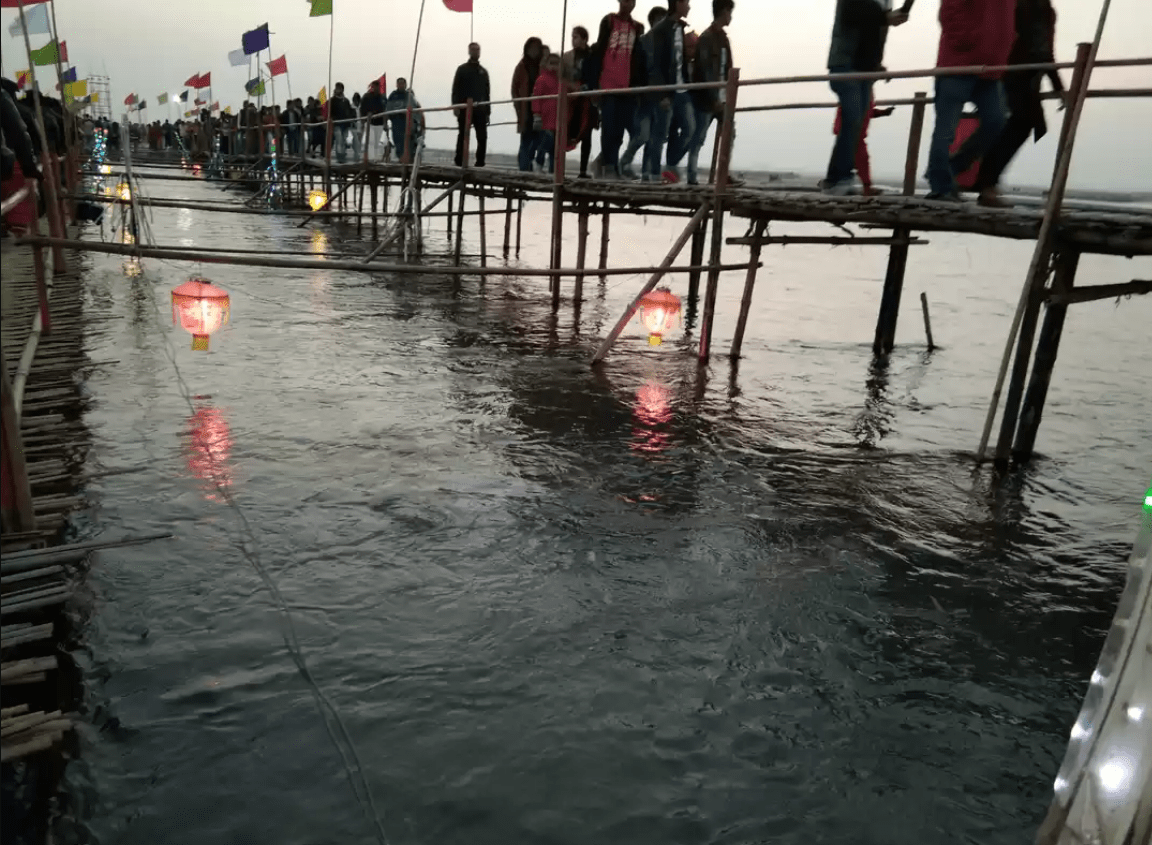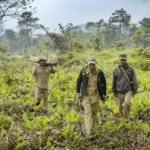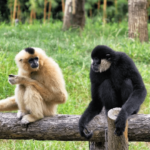Dwijing Festival: Bodoland is truly an untouched paradise, with its raw beauty and simplicity captivating anyone who visits. Our love for Northeast India has always been strong, and we were fortunate to explore this hidden gem in 2018. Following the excitement of Bascon 3.0, we eagerly anticipated experiencing another northeastern festival – the Dwijing Festival. Our enthusiasm was palpable, driven by my passion for cultures and festivals, and Agni’s love for adventure. The Dwijing Festival promised a blend of both, making it an event we couldn’t wait to attend. Moreover, we felt a deep sense of pride in being Ambassadors of Bodoland, helping to bring this beautiful region onto Assam’s tourism map.
What is Dwijing Festival?
The Dwijing Festival is an annual river festival held on the banks of the Aie River near the Hagrama Bridge in Chirang district, close to Bongaigaon. This 12-day cultural spectacle is designed to promote tourism in Bodoland, featuring a diverse range of activities including music, art exhibitions, local trade, games, and river camping. The festival offers a vibrant glimpse into the cultural life of the Bodo people.
The word “Dwijing” translates to “river bank,” aptly named as the festival takes place along the Aie River. In the Bodo language, “Aie” means “mother,” reflecting the river’s vital role in the lives and livelihoods of the 30,000 families in the Chirang district. The river, originating from the Bhutan Himalayas, flows through Chirang and Bongaigaon before merging with the mighty Brahmaputra. The Aie River is both a creator and destroyer, bringing both sustenance and devastation during the monsoon season. Thus, it is only natural that the Dwijing Festival is celebrated on its banks.
Interestingly, the Aie River changes its course every year, making the festival’s location near the Hagrama Bridge, one of Assam’s longest bridges, even more significant. The festival, which began in 2016-17, was initially known as the Aie-River Winter Festival and is now a major annual event held from December 27th to January 7th, symbolizing new hope and energy for the people of Bodoland and Assam.
Events at the Dwijing Festival
The Dwijing Festival is a 12-day extravaganza filled with excitement and fun. The festival features musical performances, art exhibitions, food and handicraft stalls, ethnic games, and cultural activities. Popular Bollywood artists like Kailash Kher, Amit Trivedi, Malaika Arora Khan, and others were part of the 2018-19 edition, adding star power to the event. However, the festival’s appeal extends far beyond celebrity appearances.
Dwijing Festival Through Our Eyes
Before attending the Dwijing Festival, we knew little about the event or Bodoland itself. The name ‘Dwijing’ intrigued us, and we approached our visit with no preconceived notions. As we arrived at Guwahati Airport, the sight of large festival hoardings signaled that this was going to be a major event.
The Venue
The first sight of the Hagrama Bridge and the riverbank left us in awe. As we entered the festival grounds, we saw shops and a stage in the distance, with the river flowing between them and bridges connecting both sides. The scale of the event was impressive. On the opposite bank were art exhibitions, adventure sports, and riverside tents. Food stalls lined the river, offering a perfect spot to relax and enjoy the New Year’s Eve fireworks.
Art and Installations
A section of the festival was dedicated to art installations by Ms. Wahida Ahmed and her team. The installations offered a unique perspective on life in the region. One piece that caught our attention was the “Weathering House” by Dhrubajit Sarma, which depicted the transient nature of rural homes in flood-prone areas through bamboo sheets that swayed in the wind, symbolizing the fragile existence of these communities.
The Fair
Fairs are always nostalgic and fun, bringing back childhood memories. The Dwijing Festival had a bustling fairground with handicrafts, handloom stalls, food stalls, and amusement rides. The giant wheel and mini toy train were particularly enjoyable, allowing us to relive our childhood excitement.
Adventure at Dwijing
For adventure enthusiasts, the Dwijing Festival offers a variety of activities including parasailing, boating, hot air ballooning, and even helicopter rides for an aerial view of the venue. Horse riding and camel safaris were also available, making it a thrilling experience for visitors.
Cultural Programs
The festival’s cultural programs featured a rich lineup of musical performances by local artists, traditional folk dances, and more. We were especially captivated by the Bihu dance, a traditional favorite, and an African dance performed by a group from Gujarat. The elegant ‘Apsara dance’ by a troupe from Thailand added an international flavor to the event. Although Bollywood performances attracted many locals, we chose to focus on the traditional aspects of the festival.
Food Fest
No festival is complete without food, and the Dwijing Festival offered a wide range of options, especially for non-vegetarians. The food stalls served delicious Assamese and Bodo dishes, while a few stalls catered to vegetarians. For the adventurous foodie, the festival was a delight, offering unique dishes like pigeon, silkworm, and snail. The tekeli pithas, a sweet dish made from rice, sesame, and jaggery, became our favorite treat.
Camping by the Riverside
For those seeking a closer connection to nature, riverside camping was available. The campsite provided a serene environment, perfect for a peaceful retreat by the river.
Mini Bodo Village
A mini Bodo village exhibit showcased traditional Bodo huts, a worship place, a barn, and other structures, offering insights into Bodo culture and daily life. We learned that the northern side of the house is reserved for elders and valuables, while the kitchen is located on the southern side.
Where is the Dwijing Festival Held?
The Dwijing Festival takes place at the Aie River Bank near the Hagrama Bridge in Chirang, close to Bongaigaon. Guwahati is the nearest airport, and from there, it’s a 3-4 hour journey by road or rail to Bongaigaon. The nearest railway station is New Bongaigaon, which is well connected to major cities.
Is Bodoland Safe to Travel?
When we mentioned our plans to visit Bodoland, our friends and family expressed concern for our safety. However, the insurgencies that once plagued Bodoland are now a thing of the past. Bodoland is as safe as any other part of India. In fact, Northeast India is one of the safest regions to travel, where guests are treated with the utmost respect. I’ve traveled solo in Garo Hills and Arunachal Pradesh without any issues, and as long as you stay alert and trust your instincts, you’ll have a safe and enjoyable trip.
A Little About Bodoland – Who are the Bodos?
The Bodos are an ethnolinguistic group of Tibeto-Burmese origin, believed to be the earliest inhabitants of Assam. Despite challenges such as illegal immigration, land encroachment, and forced assimilation, the Bodos have preserved their ethnic identity. In 2003, the Bodo leaders laid down arms, leading to the formation of the Bodoland Territorial Autonomous District (BTAD), ushering in an era of peace and progress. This peace has transformed the lives of the local people, with former wildlife poachers now becoming conservationists.
Things to Do in Bodoland Around the Dwijing Festival
Bodoland’s natural beauty offers numerous opportunities for exploration during the Dwijing Festival:
- Kalamati: Visit Kalamati near the Indo-Bhutan border for a scenic experience by the river.
- Manas National Park: Take a wildlife safari in Manas National Park, a less crowded alternative to Kaziranga, offering a more intimate connection with nature.
- Bodo Village: Experience Bodo culture firsthand by visiting a Bodo village, where you can observe traditional weaving, fishing, and cooking.
- Kokrajhar and Wildlife Sanctuaries: Explore Kokrajhar and other nearby wildlife sanctuaries for more adventures.
Final Words
The Dwijing Festival serves as a fantastic platform for promoting river and village tourism in Bodoland and Assam. This part of Assam is often overlooked by tourists, and the festival aims to change that by showcasing the region’s rich culture and natural beauty.
Jointly organized by Assam Tourism and Bodoland Tourism, the festival promises to grow bigger and better in the coming years. With its grand scale, beautiful location, and top-notch security, the Dwijing Festival is an event worth attending. There is still room for improvement in waste and plastic management, and the organizers are committed to making the festival more eco-friendly in future editions.
Where to Stay?
Festival grounds offer tent accommodations, but if you prefer more comfort, there are plenty of hotels in Bongaigaon. Public and private transportation is available from Bongaigaon to the festival venue. We stayed at Cygnett Park Meghna in Bongaigaon and found it to be a great option.


